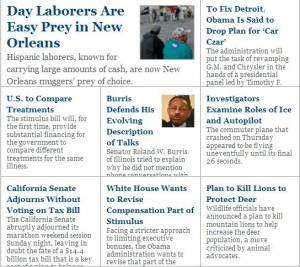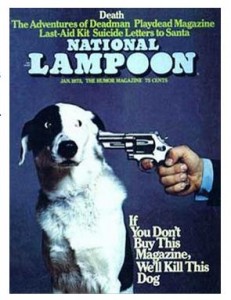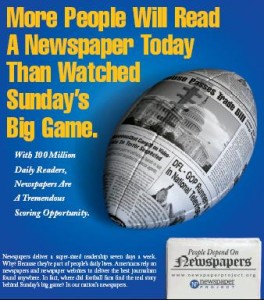 Many visitors to this website also frequent Reflections of a Newsosaur, a blog written by Alan Mutter, who is “perhaps the only CEO in Silicon Valley who knows how to set type one letter at a time.”
Many visitors to this website also frequent Reflections of a Newsosaur, a blog written by Alan Mutter, who is “perhaps the only CEO in Silicon Valley who knows how to set type one letter at a time.”
Mutter was a reporter and editor at major metro dailies for 20 years before transitioning to a successful career as a technology CEO in Silicon Valley. His blog combines an executive’s financial acumen with a journalist’s inquisitiveness. Newsosaur offers insight on the media industry’s financial condition that you just can’t get anywhere else. Not surprisingly, it is one of the top 10,000 blogs worldwide, according to Technorati.
Mutter particularly enjoys challenging conventional wisdom with mathematical fact. Early this week he poked holes in the recent excitement over micropayments by creating a likely revenue scenario. Using The New York Times as a subject, he concluded that micropayments would bring in less than $4 million a year, or enough to pay about 2% of its staff. For small papers, they would amount to beer money. Pundits have come to rely on Mutter for reality checks like that.
Knack for Numbers
His financial analyses are his signature item. Mutter sounded the alarm about the newspaper industry’s growing debt load more than four years ago, and he has methodically documented the damaging role that debt has played in limiting the industry’s options. His Default-O-Matic documents the financial viability of major players, giving early warning of who’s likely to be next off the cliff.
A complete financial restructuring of the industry is likely, Mutter says. Debt has painted publishers into a corner and many will have no choice but to walk away from their obligations and let the banks and investors sort it out. It’s not that the core business model is so bad, he says. It’s that their financials stink.
Having reader Newsosaur for a couple of years, we thought it would be interesting to find out more about the person behind it. So we called up Alan Mutter and spent an hour on the phone with him. Our complete, lightly edited interview is below for you to stream or download.
Show Notes
| :40 | His day job; how Newsosaur got started |
| 2:45 | His background in newspapers and transition to high-tech executive |
| 9:40 | The same problems he was writing about in 2004 are still apparent today. “It’s been the same story for the four years. The difference is that publishers are running out of options.” |
| 12:30 | How the industry has responded to his warnings: “A lot of denial.” |
| 15:00 | How this mess could have been avoided: “Giving away all this content for free was the original sin.”
How newspapers failed to adapt their products to the unique environment of the Web. |
| 22:00 | The Coca-Cola analogy: A company adapts to continually changing market conditions |
| 25:00 | Newspaper companies have enjoyed “a phenomenal number of unfair advantages” that could have been exploited but executives failed to innovate. How rampant layoffs are destroying newspapers’ core strength. |
| 28:00 | Most broadcast outlets have almost no reporting staff; what happens when the local newspaper disappears? |
| 30:30 | “What will American democracy be in like in the absence of a vigorous press? We’ve never seen that. Ever.” |
| 33:30 | The dubious possibility that citizen journalists and bloggers will fill the vacuum. |
| 37:40 | The outlook for 2009: “It’s not that the underlying business is so bad but that these companies are heavily laden with debt.” Large-scale revaluations will be needed. |
| 43:00 | Threat to the core business: “When we come out of this, people will still buy cars but I’m not sure they’ll buy newspapers.” |
| 45:00 | Why micropayments and endowment solutions won’t work. |
| 48:00 | Who’s doing it right: innovation at the local level. |
| 51:00 | The Chicago Tribune‘s play for young readers. |
| 53:15 | How the Newsosaur blog has changed his world; the industry’s reaction. |
| 56:00 | Even at this late date, there are things that could be done. Have media companies called him for advice? “A few, but there’s room for more.” |
| 57:30 | How business models can successfully be blown up. |
Download the interview (right-click and save)
Stream the interview:[audio:Alan_Mutter_NDW_Interview.mp3]


 Is Mortimer Zuckerman losing it? Or perhaps
Is Mortimer Zuckerman losing it? Or perhaps 
 A decade ago, Napster briefly tried to make music free. When the Recording Industry Association of America applied legal pressure to shut down Napster, the wisdom was that music-sharing would simply be driven underground in a maze of peer-to-peer networks like BitTorrent and
A decade ago, Napster briefly tried to make music free. When the Recording Industry Association of America applied legal pressure to shut down Napster, the wisdom was that music-sharing would simply be driven underground in a maze of peer-to-peer networks like BitTorrent and  The status of newspapers as essential utilities gets a boost in a
The status of newspapers as essential utilities gets a boost in a  The all-or-nothing scenario outlined in this report is fundamentally flawed. It’s surprising that the usually thorough NPR editors would let such a myopic analysis go through. Maybe the layoffs there are having an impact.
The all-or-nothing scenario outlined in this report is fundamentally flawed. It’s surprising that the usually thorough NPR editors would let such a myopic analysis go through. Maybe the layoffs there are having an impact.  Yesterday was black Thursday in newspaper land as four media companies reported dismal earnings, seven small newspapers shut down and publishers braced the public for more layoffs.
Yesterday was black Thursday in newspaper land as four media companies reported dismal earnings, seven small newspapers shut down and publishers braced the public for more layoffs.




